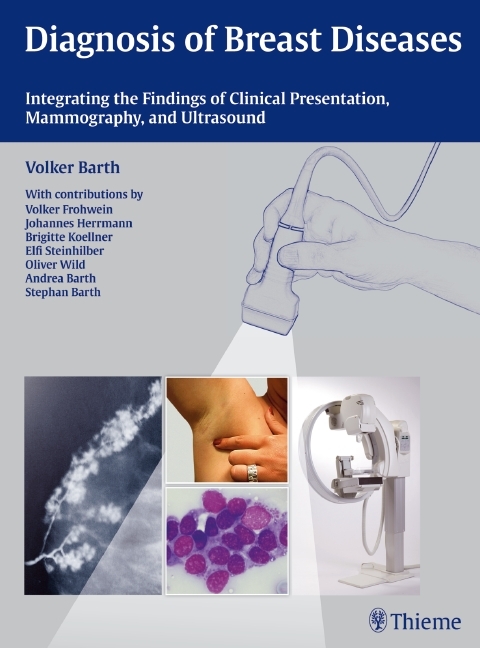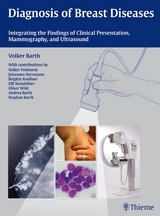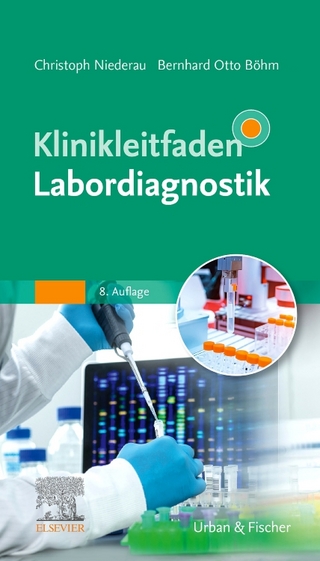Diagnosis of Breast Diseases
Integrating the Findings of Clinical Presentation, Mammography, and Ultrasound
Seiten
2011
Thieme (Verlag)
978-3-13-143831-7 (ISBN)
Thieme (Verlag)
978-3-13-143831-7 (ISBN)
The Concept:
Clinical presentation, sonography, and mammography are the three pillars upon which the concept of this atlas is based. The strengths and weaknesses of these three pillars are fully explored, and it is shown how all three can be optimally integrated and supplemented to yield a confident and efficient diagnosis. Coverage includes digital mammography, positron emission tomography, and sentinel node biopsy. More than 1700 illustrations with clinical photographs, ultrasound images, and mammograms document our approach to establishing an accurate diagnosis for the various forms of breast cancer.
The Contents:
Aspects of Tumor Biology
- Causes, Growth Factors, Endocrine and Exocrine Influences
- Hormone Replacement Therapy in Menopause
- Predisposing Genetic Factors
- Case-Control Study
Prognostic Factors
- Growth Rate, Tumor Size, Lymph Node Involvement, and Prognosis
Histology, Radiography, and Ultrasound
- Anatomy
- Terminal Duct-Lobular Unit
- Atypical Ductal Hyperplasia (ADH) and Noninvasive Carcinoma (DCIS, LCIS)
- Invasive Carcinoma
- Histologic Classification, Staging, and Grading of Invasive Carcinoma
Early Detection
- Diagnostic Options
- Inspection and Palpation
- Digital and Analog Mammography
- Accreditation Test Questions
- Possibilities and Limitations of Screening
- Sonography
- Axillary Structures on Mammograms and Sonograms
- Magnetic Resonance Imaging
- Positron Emission Tomography
- Capabilities, Limitations, and Risks of Interventions
- Possibilities and Limitations of Complementary Investigations
- Breast Cancer in Younger Women
- Male Breast Cancer
- Perioperative Management
- Postoperative Changes, Gynecomastia, and Follow-Up Care
Clinical presentation, sonography, and mammography are the three pillars upon which the concept of this atlas is based. The strengths and weaknesses of these three pillars are fully explored, and it is shown how all three can be optimally integrated and supplemented to yield a confident and efficient diagnosis. Coverage includes digital mammography, positron emission tomography, and sentinel node biopsy. More than 1700 illustrations with clinical photographs, ultrasound images, and mammograms document our approach to establishing an accurate diagnosis for the various forms of breast cancer.
The Contents:
Aspects of Tumor Biology
- Causes, Growth Factors, Endocrine and Exocrine Influences
- Hormone Replacement Therapy in Menopause
- Predisposing Genetic Factors
- Case-Control Study
Prognostic Factors
- Growth Rate, Tumor Size, Lymph Node Involvement, and Prognosis
Histology, Radiography, and Ultrasound
- Anatomy
- Terminal Duct-Lobular Unit
- Atypical Ductal Hyperplasia (ADH) and Noninvasive Carcinoma (DCIS, LCIS)
- Invasive Carcinoma
- Histologic Classification, Staging, and Grading of Invasive Carcinoma
Early Detection
- Diagnostic Options
- Inspection and Palpation
- Digital and Analog Mammography
- Accreditation Test Questions
- Possibilities and Limitations of Screening
- Sonography
- Axillary Structures on Mammograms and Sonograms
- Magnetic Resonance Imaging
- Positron Emission Tomography
- Capabilities, Limitations, and Risks of Interventions
- Possibilities and Limitations of Complementary Investigations
- Breast Cancer in Younger Women
- Male Breast Cancer
- Perioperative Management
- Postoperative Changes, Gynecomastia, and Follow-Up Care
lt;p>1 Introduction
2 Aspects of Tumor Biology
Causes, Growth Factors, Endocrine and Exocrine Influences
Hormone Replacement Therapy in Menopause
Predisposing Genetic Factors
Case-Control Study on Sports and Breast Cancer
Summary
3 Prognostic Factors
Growth Rate, Tumor Size, Lymph Node Involvement, and Prognosis
4 Macroanatomy, Histology, Radiography, and Ultrasound
Anatomy of the Breast: Lobes, Lobules, and the Terminal Duct Lobular Unit (TDLU)
Terminal Duct Lobular Unit: Microradiography, Mammography, and Sonography
Conclusions
5 Early Detection and Appropriate Treatment
Diagnostic Options
Possibilities and Limitations of Complementary Investigations
Therapy and Perioperative Management
Postoperative Changes and Follow-Up
Answers
6 Summary
| Erscheint lt. Verlag | 26.1.2011 |
|---|---|
| Verlagsort | Stuttgart |
| Sprache | englisch |
| Maße | 230 x 310 mm |
| Gewicht | 2145 g |
| Themenwelt | Medizin / Pharmazie ► Medizinische Fachgebiete ► Gynäkologie / Geburtshilfe |
| Studium ► 2. Studienabschnitt (Klinik) ► Anamnese / Körperliche Untersuchung | |
| Schlagworte | Bildgebendes Diagnoseverfahren • biopsy • Breast • Breast Cancer • Brusterkrankung • Brustkrebs • Brustkrebs / Mammakarzinom • Brust (weibl.) • Diagnosis • Diagnostik • Diagnostisches Vorgehen • Diseases • Früherkennung • Grading • Histologie • Hormone • Hormoneinfluss • Hormonersatztherapie • Klassifikation • Klinik • Krebs (Medizin) • Lympfknoten • Lympfknotenbeteiligung • Mamma • Mammadiagnostik • Mammographie • Mammography • Prognose • Prognostische Faktoren • Radiographie • radiography • Radiologie • Screening • Sonographie • sonography • Staging • Tumor • Tumorbiologie • tumor biology • Tumorklassifikation • Ultrasound |
| ISBN-10 | 3-13-143831-2 / 3131438312 |
| ISBN-13 | 978-3-13-143831-7 / 9783131438317 |
| Zustand | Neuware |
| Haben Sie eine Frage zum Produkt? |
Mehr entdecken
aus dem Bereich
aus dem Bereich
aus Klinik und Praxis
Buch | Softcover (2023)
Urban & Fischer (Verlag)
42,00 €
Buch | Hardcover (2017)
Hogrefe (Verlag)
60,00 €
Buch | Softcover (2024)
Urban & Fischer in Elsevier (Verlag)
56,00 €




